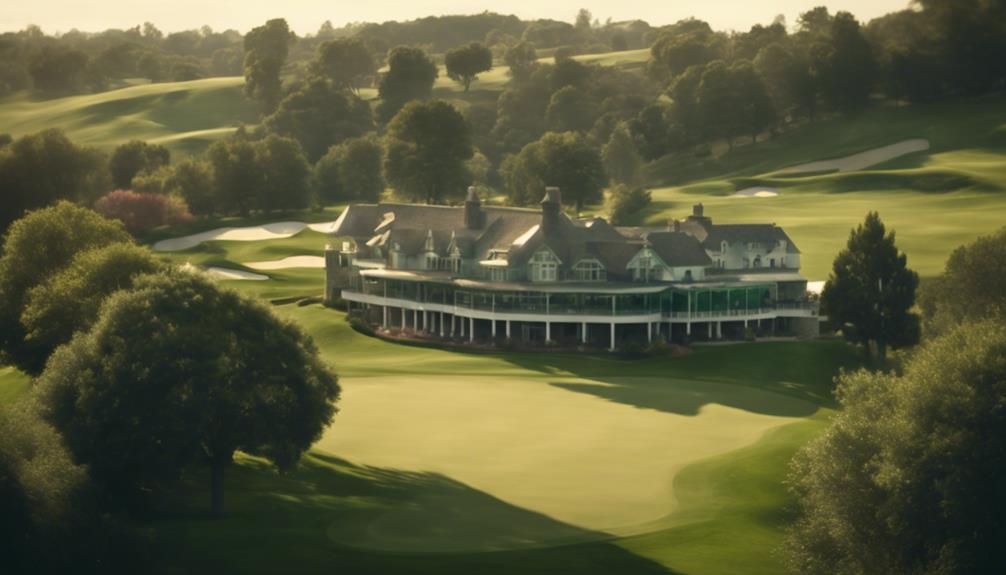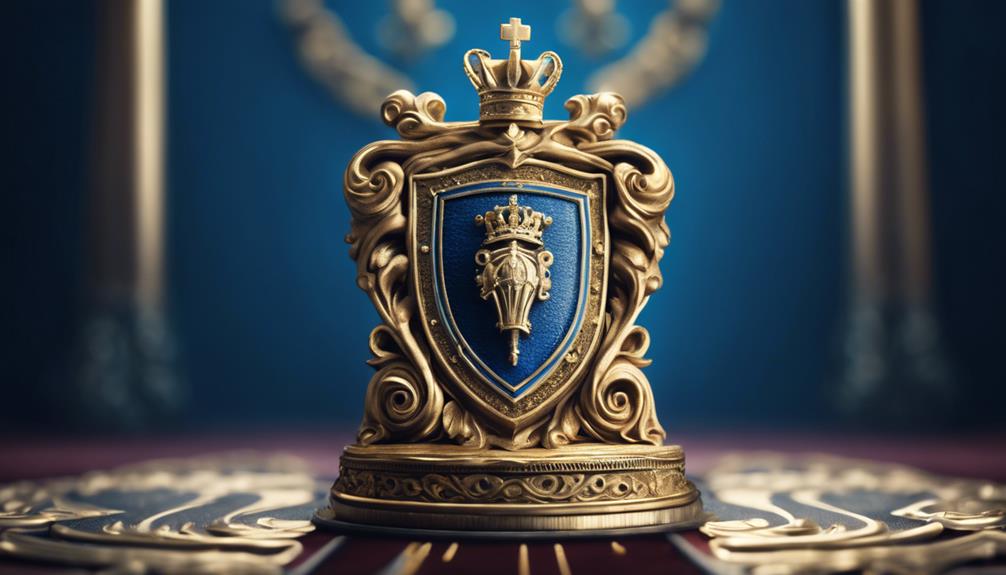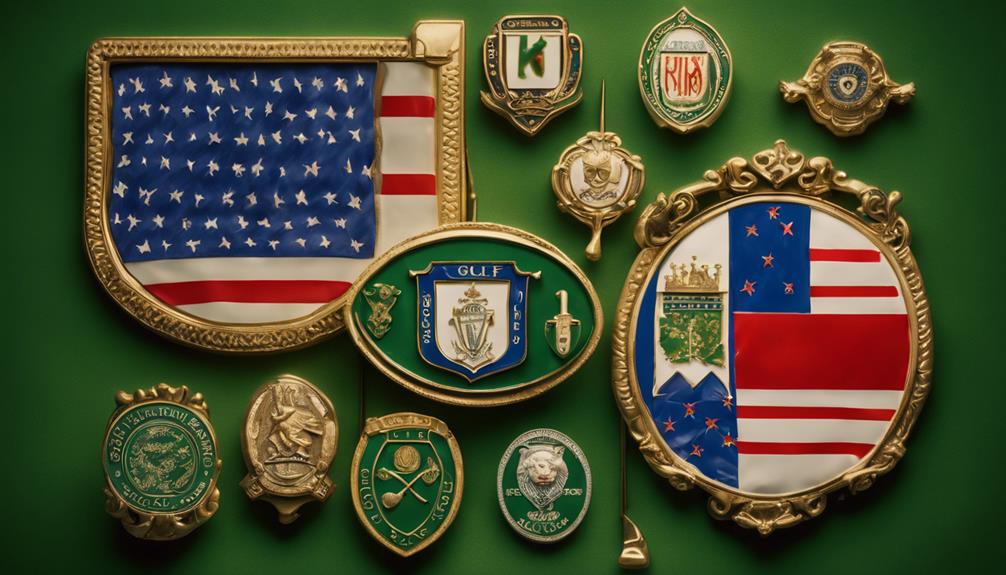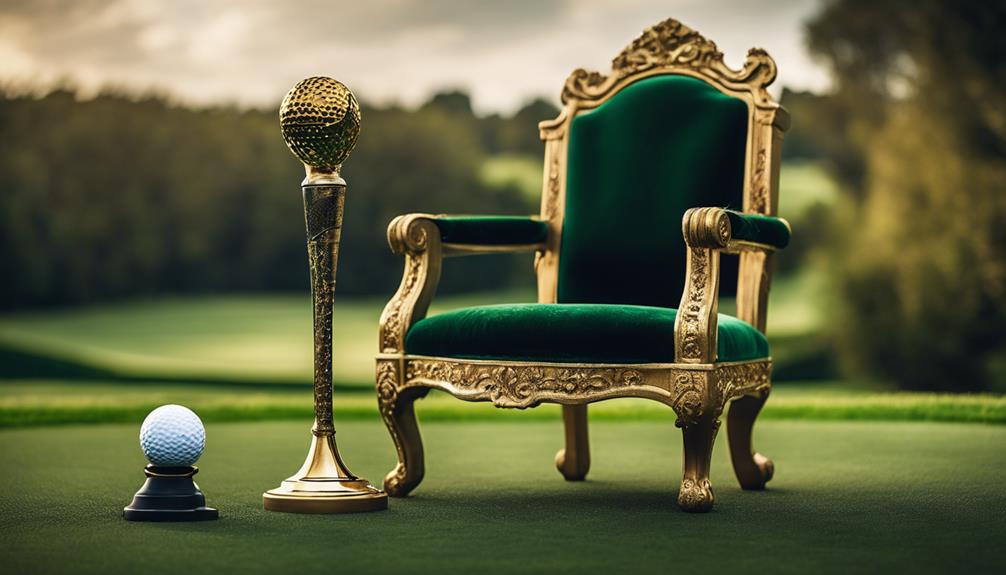- 7 Top Flite Golf Clubs XL for Improved Performance - September 28, 2024
- Top Flite Golf Clubs: Top 5 Reasons to Choose Them - September 28, 2024
- Top 3 Golf Club Fitters for a Perfect Swing - September 28, 2024
When you wonder if a golf club can earn royal status, you're asking about a prestigious designation that's been around since 1833. To get it, a club must demonstrate exceptional eminence, financial stability, and a commitment to the national game, with the reigning monarch holding the power to grant this honor. The application process is meticulous, ensuring only elite clubs receive the royal title. If a club meets the stringent criteria, it joins an exclusive group of esteemed golf clubs around the world. Now, explore the fascinating history and significance behind this coveted title, and discover what sets these exceptional clubs apart.
Key Takeaways
- A golf club can get royal status through a meticulous evaluation and approval process involving the reigning monarch.
- The club must demonstrate eminence, financial stability, and national commitment to be considered for royal status.
- The application process involves a thorough examination of the club's credentials, historical significance, and dedication to national objectives.
- Only a select few clubs have been granted royal status, with no recorded instances of clubs being denied.
- The reigning monarch holds the power to grant royal status, reflecting the club's hard work and dedication.
Origins of Royal Golf Clubs
As you explore the prestigious world of golf clubs, you'll discover that the concept of royal status originated in 1833, when King William IV bestowed this esteemed title upon the Perth Golfing Society, marking a significant milestone in the history of golf.
This royal recognition not only elevated the Perth Golfing Society's reputation but also paved the way for other clubs to aspire for similar eminence. The granting of royal status was initially limited to clubs in the British Isles, but it eventually extended to clubs in British colonies and other countries, solidifying golf's global appeal.
The Royal and Ancient Golf Club of St. Andrews, which operates the iconic Old Course, is a notable example of a club that has earned royal status, highlighting the historical significance of this distinction. While the formal application process for royal status wouldn't be established until later, the Perth Golfing Society's royal title set a precedent for excellence in golf, encouraging other clubs to pursue this coveted honor.
Application and Approval Process
As you explore the Application and Approval Process, you'll discover that the path to achieving Royal status involves a meticulous evaluation of a golf club's credentials.
You'll need to demonstrate a strong case for your club's eminence, financial stability, and commitment to national objectives, all of which will be scrutinized before the final approval is granted.
Ultimately, it's the reigning monarch who holds the power to bestow this prestigious designation, making the approval process a rigorous and esteemed undertaking.
Reigning Monarch's Approval
When pursuing Royal status, golf clubs must formally request the reigning monarch, who ultimately holds the reins in granting this prestigious recognition, and undergo a rigorous application process that scrutinizes their eminence and financial stability.
You'll need to showcase your club's exceptional standing and sound financial foundation to gain the monarch's approval. This rigorous vetting process ensures that only the most elite clubs receive the coveted Royal status. Curiously, there's no recorded instance of a golf club being denied this honor, suggesting that the application process is more of a formality for clubs that have already established their excellence.
Many clubs, particularly those in British colonies, sought Royal designation around the turn of the 20th century, and it's likely that their requests were carefully reviewed before approval. Ultimately, the reigning monarch's approval is the final hurdle in achieving Royal status, and it's a reflection of the club's hard work and dedication.
Formal Application Process
You'll need to submit a thorough application package, replete with meticulous documentation, to initiate the formal process of seeking Royal status, which scrutinizes your club's credentials and commitment to national objectives.
This formal application process is a rigorous examination of your club's eminence, financial stability, and dedication to national objectives. To increase your chances of attaining Royal status, you should be prepared to demonstrate:
- A strong commitment to national causes and objectives
- A proven track record of financial stability and responsible management
- Historical significance and a rich heritage in the sport
- A robust governance structure and transparent decision-making processes
- A clear vision for the future development of golf in your region
The reigning monarch has the final approval for granting Royal status, and clubs in British colonies have also sought this prestigious designation, expanding the reach of Royal golf clubs worldwide.
Growth of Royal Golf Courses

As you explore the growth of Royal golf courses, you'll notice a significant surge in the number of clubs receiving Royal status during the late 19th and early 20th centuries.
This rapid expansion raises questions about the criteria used to select these courses, and you'll soon discover that it's not just about prestige.
You'll also learn how Royal golf courses have spread globally, with new additions during Queen Elizabeth II's reign, including the most recent one in 1978.
Royal Status Boom
Between 1882 and 1897, a notable increase in Royal status grants saw 19 prestigious golf clubs joining the esteemed ranks, setting the stage for a period of unprecedented growth in the world of royal golf. This royal status boom marked a significant milestone in the evolution of golf club traditions.
As you explore the world of royal golf, you'll discover:
- The Royal and Ancient Golf Club of St. Andrews, with its iconic Old Course, boasts historical significance and esteemed status.
- Troon, the most recent addition to the Open Championship rota among Royal clubs, received its title in 1978.
- Nine new Royal courses were added during Queen Elizabeth II's reign, showcasing the continued growth and prestige of Royal golf clubs.
- The process of granting Royal status reflects the evolving criteria for achieving prestigious recognition.
- The increase in Royal status grants between 1882 and 1897 laid the foundation for the growth of royal golf courses, solidifying their place in the sport's heritage.
This royal status boom highlights the importance of golf clubs' traditions and their pursuit of esteemed recognition, further underscoring the significance of Royal golf clubs in the world of golf.
Course Selection Criteria
As you explore the growth of Royal golf courses, you'll notice that during this period of rapid growth, the criteria for selecting courses to receive Royal status underwent significant transformation, reflecting the changing values and priorities of the golfing community. The selection process became more rigorous, focusing on courses that demonstrated outstanding quality, historical significance, and elite status.
You'll observe that the Open Championship played a vital role in course selection, with many Royal courses hosting the prestigious tournament. The Royal and Ancient Golf Club of St. Andrews, which operates the Old Course with Royal status granted in 1934, is a prime example of this.
Under Queen Elizabeth II's reign, nine new Royal courses were added, recognizing elite clubs that upheld the highest standards of golfing excellence. Troon, which received Royal status in 1978, is the most recent addition to the Open Championship rota.
As you explore further, you'll realize that the criteria for Royal status have adjusted to acknowledge the evolving golfing landscape, ensuring that only the most exceptional golf clubs are bestowed with this prestigious honor.
Global Expansion
You're witnessing a remarkable surge in Royal golf courses across the globe, with a staggering 40 clubs granted prestigious recognition between 1882 and 1937, underscoring the rapid expansion of elite golfing institutions. This period of significant growth in Royal status paved the way for a continued global expansion of golf clubs with elite status.
The Royal and Ancient Golf Club of St. Andrews, operating the Old Course with Royal status since 1934, maintains a key position in golf history.
Troon's Royal status in 1978 marked the most recent addition to the Open Championship rota, solidifying its elite status in the golfing world.
Nine new Royal courses were added during Queen Elizabeth II's reign, showcasing a continued expansion of Royal designation across different countries.
Recent additions like Auckland in New Zealand (2010) and Homburger in Germany (2013) demonstrate a continued global spread of Royal golf clubs.
The global expansion of Royal golf courses has led to a diverse range of clubs, each with its unique character and history, yet united by their prestigious recognition.
As you explore the world of Royal golf courses, you'll discover a rich tapestry of history, tradition, and excellence, underscoring the significance of Royal status in the golfing world.
Historical Significance of Royal Clubs
In the world of golf, a royal title has been the pinnacle of achievement for esteemed clubs since 1833 when King William IV bestowed the honor upon the Perth Golfing Society, forever changing the landscape of the sport.
You may wonder what makes these Royal golf clubs so special. The answer lies in their historical significance. These prestigious clubs have secured a secure financial position, aligning with national objectives, and have undergone a formal application process, ultimately earning the approval of the reigning monarch.
The Royal and Ancient Golf Club of St. Andrews, for instance, operates the iconic Old Course, which was granted Royal status in 1934. This showcases the historical significance of Royal clubs in the golfing world.
Over the years, 19 clubs received Royal status between 1882 and 1897, and an additional 21 clubs were named Royal from 1902 to 1937. The most recent addition to the Open rota is Troon, which received Royal status in 1978.
These clubs have cemented their place in golfing history, and their Royal status is a demonstration of their excellence.
Recent Additions to Royal List

Recent additions to the esteemed list of Royal golf clubs include Auckland, which was granted Royal status in 2010, becoming the first in New Zealand to receive this prestigious honor. You may wonder what other courses have recently joined this exclusive group.
Here are some notable recent additions to the Royal list:
- Auckland (2010) – the first in New Zealand
- Moresby (2012) – in Papua New Guinea
- Homburger (2013) – in Germany
- Troon (1978) – part of the Open rota
- The Royal and Ancient Golf Club of St. Andrews (1934) – operating the iconic Old Course
These courses have earned their place among the world's most esteemed golf clubs, and you can imagine the sense of pride and prestige that comes with bearing the Royal title.
As you explore the world of golf, you'll likely come across these names again, and now you'll know the significance behind their Royal status.
Criteria and Status of Royal Clubs
The granting of Royal status to a golf club is a distinguished honor that is bestowed upon only a select few, with the reigning monarch carefully considering a range of criteria before bestowing this prestigious title. As you explore the world of golf clubs around the globe, you'll notice that not all clubs with 'Royal' in their name have official Royal status granted by a monarch. In fact, some clubs adopt the Royal title due to historical or geographical ties, rather than through official approval.
To gain Royal status, a golf club must meet specific criteria, including dedication to national, charitable, and scientific causes. The club must also demonstrate eminence, financial stability, and a commitment to upholding the values of the monarchy. The process of attaining Royal status involves a formal application and approval process, with the reigning monarch having the final say.
| Criteria | Description | Example |
|---|---|---|
| Eminence | Exceptional reputation and achievements | Hosting international golf tournaments |
| Financial Stability | Strong financial foundation | Consistent annual profits |
| Historical Ties | Significant connections to the monarchy or national heritage | Founded by a royal family member |
Examples of Royal Golf Clubs Worldwide

You'll find royal golf clubs scattered across the globe, with some of the most prestigious examples being the Royal Melbourne Golf Club in Australia, Royal Portrush Golf Club in Northern Ireland, and Royal St. Georges Golf Club in England, each boasting a rich history and esteemed reputation.
These clubs have earned their royal status through a combination of their heritage, excellence, and patronage from British monarchs. Take a closer look at these illustrious clubs:
- Royal Melbourne Golf Club: granted royal status by King George VI in 1949
- Royal Portrush Golf Club: received its royal designation from Queen Victoria in 1892
- Royal St. Georges Golf Club: became royal under King Edward VII in 1902, the first club outside Scotland to host the Open
- The Royal and Ancient Golf Club of St. Andrews: granted royal status by King William IV in 1834
- Royal Troon Golf Club: earned its royal title from Queen Elizabeth II in 1978 and is part of the Open rota
These clubs embody the essence of golfing excellence, and their royal status is a tribute to their commitment to the sport.
Ownership and Prestige of Royal Clubs
Beyond the prestige and honor that comes with royal status, golf clubs bearing this distinction often possess a unique set of circumstances surrounding ownership, with some surprising nuances that set them apart from their non-royal counterparts. You might assume that a Royal golf club owns its course, but that's not always the case. In fact, the title is granted based on eminence, history, and financial stability, rather than ownership. This is evident in the table below, which highlights the varying circumstances of Royal golf clubs worldwide.
| Club | Ownership | Prestige Factor |
|---|---|---|
| Royal Antwerp Golf Club | Leased | Automatic 50-year Royal status in Belgium |
| Royal Birkdale Golf Club | Member-owned | Hosted numerous Open Championships |
| Royal Golf Club of Belgium | Privately owned | Granted Royal status by King Albert I |
| Royal Dublin Golf Club | Member-owned | One of the oldest golf clubs in Ireland |
| Royal Porthcawl Golf Club | Council-owned | Hosted the 2014 Senior Open Championship |
As you can see, ownership and prestige are key factors in the criteria for receiving and maintaining Royal status at golf clubs. With their rich history, exclusivity, and financial stability, it's no wonder these clubs are considered the crème de la crème of the golfing world.
Characteristics of Royal Golf Clubs

As you explore the world of Royal golf clubs, it becomes clear that these esteemed institutions share a distinct set of characteristics that set them apart from other golf clubs. These clubs have earned their Royal status through a combination of eminence, history, and financial stability, meeting the criteria set by reigning monarchs.
Here are some key characteristics that define Royal golf clubs:
- Eminence: They've a reputation for excellence, attracting elite members with wealth and influence.
- History: They've a rich heritage, often with connections to royal families or national events.
- Financial Stability: They've a strong financial foundation, ensuring their continued existence and ability to support charitable causes.
- Exclusive Membership: They offer exclusive membership opportunities, reserved for those who share their values and commitment to the game.
- National Dedication: They demonstrate dedication to national and charitable causes, going beyond mere golfing enthusiasts.
These characteristics not only distinguish Royal golf clubs from others but also reflect their commitment to upholding the highest standards of the game.
Frequently Asked Questions
What Does "Royal" Mean for a Golf Course?
When you see "royal" attached to a golf course, you're dealing with a prestigious title that signifies historically significant, exclusive membership, and high standards, often featuring luxury amenities, top-rated courses, and royal connections, earning global recognition through a time-honored tradition.
How Many Golf Courses Are Called Royal?
You'll find that 66 famous courses worldwide boast the esteemed Royal title, situated in prestigious locations, enjoying global recognition for their historical significance, exacting membership requirements, and showcasing architectural beauty, tournament hosting, exclusive amenities, and a rich tradition and legacy.
What Does It Mean to Belong to a Country Club?
Belonging to a country club is like being part of an elite clique, where you'll rub shoulders with affluent members at exclusive social gatherings and prestigious events, enjoying luxury amenities, private facilities, and networking opportunities, all while upholding tradition and history, but be prepared for high membership fees.
Does the Royal Family Play Golf?
You'll find the royal family enthusiastically embracing golfing, adhering to royal etiquette on the course, donning traditional attire, and frequenting prestigious clubs, all while participating in charity tournaments and upholding century-old golf traditions.
Conclusion
As you step onto the lush greens of a royal golf club, you're walking in the footsteps of nobility. The prestige and exclusivity of these clubs are unmatched, with a rich history and strict criteria for membership.
With fewer than 70 royal clubs worldwide, the elite status is reserved for the crème de la crème of golfing institutions. So, if you're lucky enough to tee off at one, savor the experience – you're part of a select group that's truly fit for a king.




